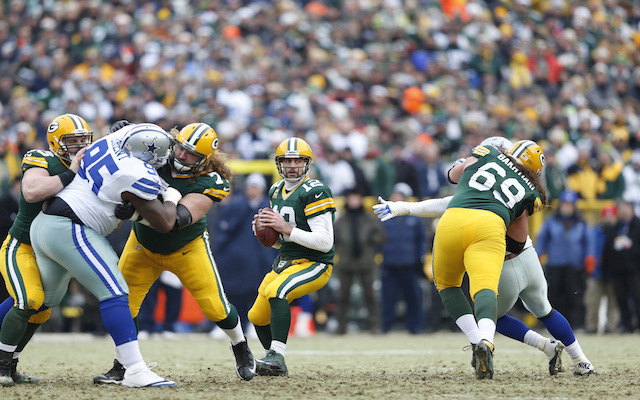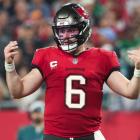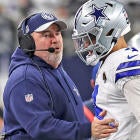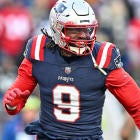As you may or may not have heard 100 or so times over the last two weeks, Aaron Rodgers has a calf injury. Said injury limited his mobility in the second half of the Packers' Week 17 victory over the Detroit Lions, as well as most of the divisional round defeat of the Dallas Cowboys.
Rodgers looked particularly hampered during the first half of that Dallas game, often sitting in the pocket far longer than he normally does in the face of a late rush. Rodgers will usually move to his right or left to escape a rush and buy time for Jordy Nelson or Randall Cobb to get open, but he just did not seem to have the ability to do so in the first half against Dallas.
As a result, he completed just 9 of 15 passes for 90 yards and a TD. He was also sacked once and he fumbled the ball on another play that started with an aborted snap and ended with Rodgers unable to escape Jeremy Mincey.
Rodgers moved around a bit better after halftime, but he also didn't really have to. Green Bay's offensive line kept him upright and away from the Dallas pass rush almost entirely, giving him time to step up and deliver the ball on schedule and on target. He finished the second half 15 of 20 for 226 yards and two touchdowns, including a 7-of-7, 78-yard performance on what turned out to be the winning drive. That ended with Rodgers stepping up and to his left, then delivering this absolute bullet to Richard Rodgers in the back of the end zone and between two defenders.
That does not look like a man bothered by a calf injury. For what it's worth, Green Bay head coach Mike McCarthy said Monday that Rodgers' calf was doing better at that point than it was the previous week. On Tuesday, though, Rodgers himself said, "It's not better. It's worse than when I started the game but it's doing OK. I'm tired of talking about it. It is what it is. It's a significant injury. I was able to get through it." Rodgers also let on that, "I think I've got 120 minutes left in me," likely meaning he can get through the NFC Championship Game and the Super Bowl, but that something would have to be done after that.
The Seahawks, on their end, are not buying any talk of Rodgers' injury limiting him. "I'm not buying into this leg issue," safety Earl Thomas said. "I saw him scramble close to the goal line on the Cowboys, so he's not fooling me with that. I'm not falling into that."
That ability to scramble away from the rush -- even for just a second -- and buy time will be significantly more meaningful against the Seahawks than it was against the Cowboys. As much as the Dallas defense was an improved unit this season, it still pales in comparison to the Seattle defense, which of late is looking very much like last season's version.
Dallas sacked the quarterback only 28 times all season, posting a 6.6 percent Adjusted Sack Rate according to Football Outsiders. Seattle's rush was considerably better; their 8.0 percent Adjusted Sack Rate ranked fifth best in the league, and that includes their early-season struggles getting to the passer. Cliff Avril and Michael Bennett combined for 136 quarterback pressures in the regular season, more than any other duo of 4-3 defensive ends in the NFL. Add in the additional outside rush created by Bruce Irvin and O'Brien Schofield and Seattle can bring more pressure than pretty much any team in the league, even in the absence of pass-rushing defensive tackle Jordan Hill.
Pressure on the edges will force Rodgers to move away from his position deep in the pocket, and if he's moving around like he did in the first half against Dallas last week, that's a problem. If he can skirt the rush for a half-second or so, stand tall and deliver as he did in the second half, it's much less of a problem. If he's moving around like Rodgers normally does, then getting outside the rush and buying time for his receivers becomes a bigger factor. Based on his movements last week and his comments about the state of his calf, though, it's not especially reasonable to expect him to move around like he did for most of the regular season and most of his career.
Getting the ball out quickly, then, will be a key. The Packers do have their fill of quick slant throws in the offense, but Rodgers tends to hold the ball and wait longer than most quarterbacks when he's really going right. He held the ball for an average of 2.86 seconds before throwing this season; only five quarterbacks had a higher number. He also had a better quarterback rating by nearly six full points when he held onto the ball for more than 2.6 seconds than when he got it out quicker than that. With his mobility limited, though, it makes sense to get the ball out fast and let his receivers run after the catch.

Even when he was able to maneuver his way around consistently back in Green Bay's Week 1 loss to the Seahawks, it didn't make much of a difference. Seattle only pressured Rodgers on eight of his 32 throws in that game, and he still completed just 23 passes for a pedestrian 189 yards. Rodgers completely avoided the right side of the field -- he didn't target a receiver covered by Richard Sherman all game. Sacrificing an entire side of the field is simply not a sustainable offensive strategy, though, and that bore itself out in the result. Pretty much the only space Rodgers could find to deliver the ball was within 10 yards of the line of scrimmage. A significant amount of his damage was done by throwing short passes to Nelson working on Byron Maxwell -- that specific matchup yielded an 8-of-10 passing performance for 71 yards. He completed only 3 of 11 passes for 50 total yards on throws more than 10 yards down the field, and he was intercepted on one of them.
Rodgers has been saying the right things about being more willing to challenge Sherman this time around. He indicated that he has respect for Sherman and that he has to know where the corner is at all times -- hint: to the offensive right side of the field -- but that he'll throw on anyone if he has to. It should help that No. 3 receiver Jarrett Boykin, who was Sherman's sacrificial lamb back in the season opener, has since been replaced by rookie Davante Adams. Adams has made numerous big plays throughout the season, and was arguably Green Bay's most productive offensive player in the divisional win over the Cowboys. His winning the matchup with nickel corner Sterling Moore swung the game just as much, if not more, than the controversial overturned catch by Dez Bryant.
Adams' emergence will allow the Packers to move Nelson and Cobb around the field more, maybe even using them on Sherman's side of the field in this one. Cobb will still work primarily out of the slot, of course -- he ran more than 87 percent of his routes from the slot this season. But using Nelson, not just Adams, to challenge Sherman will open up both sides of the field for Rodgers to work.
What should also help Rodgers here is the improved play of running back Eddie Lacy. Lacy ran 12 times for only 34 yards against Seattle in Week 1, part of a four-week slump to open the season in which he totaled just 161 yards on 53 carries. In the past seven games, though, Lacy has failed to top 95 yards rushing only once, gaining 693 yards on 136 carries. If Lacy can get a rhythm going against the Seattle run defense, that should open up the play-action game for Rodgers. As we described last week, Seattle has been somewhat vulnerable this season to teams that run the ball a lot and judiciously mix in play-action passes, while Rodgers was the No. 3 highest-rated play-action passer in the NFL this season.
>> What about AFC title game? Key Colts-Patriots matchups

















